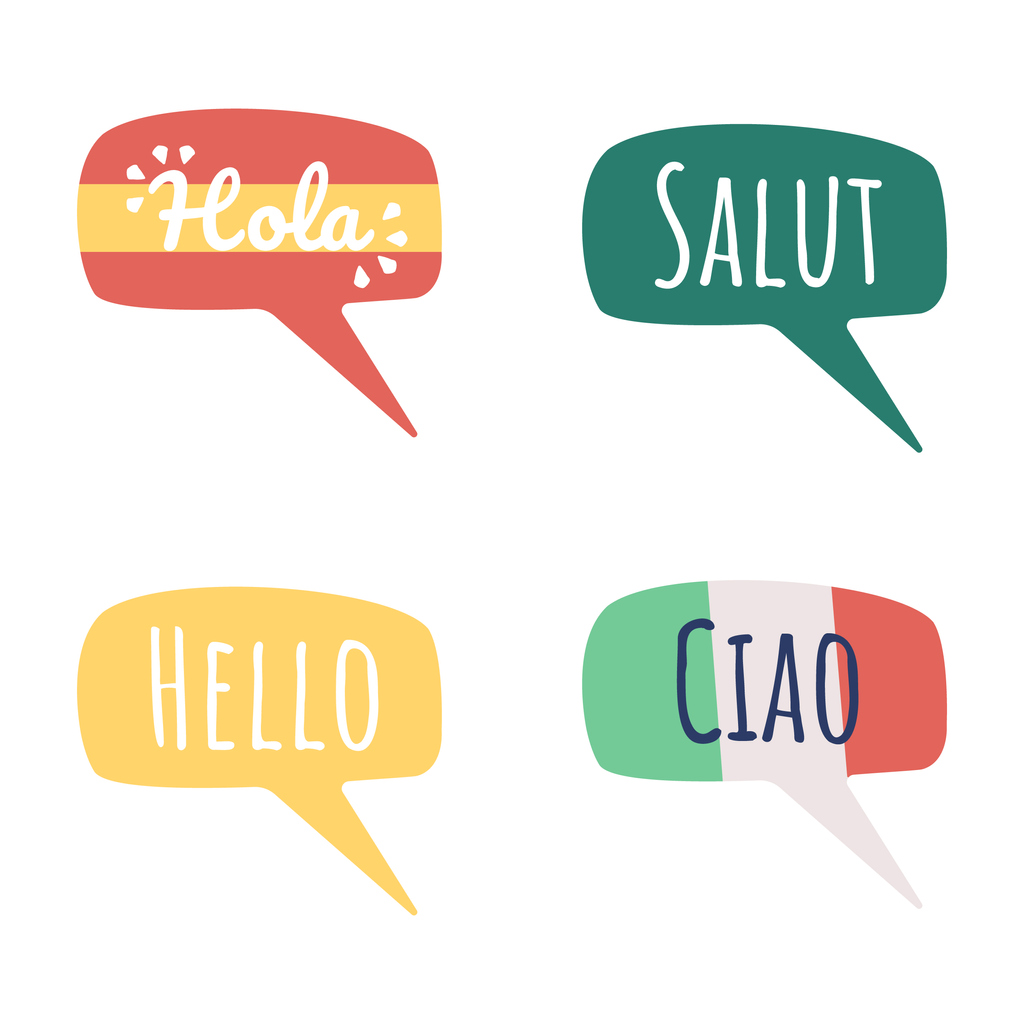Want to learn a new language? Great! Self-learning a language is a fantastic way to connect with a new culture, boost your brain, and open up the possibility of speaking with people all around the globe. Maybe you have to learn a new language for work, maybe you’re dating a non-native English speaker and want to learn their language, or maybe you’ve always dreamed of reading the Iliad in the original Greek. Whatever your motivations are, it’s never too late to learn a new language.
The great news is that you don’t have to go back to school. These days, an internet connection is all you need to self-learn a new language on your own. If you’re wondering how to learn a new language by yourself, check out the tips and resources below.
Choose Your Main Course

No, we’re not talking about meals; we’re talking language courses!
There are so many options out there when it comes to learning a foreign language – classes, apps, books, podcasts, movies, flashcards, workbooks, textbooks, and on and on. It’s awesome! But it can also lead to scattered learning.
If your strategy is to take a little bit of this and a little bit of that, you could end up with some big knowledge gaps that leave you confused. Instead, pick one beginner’s course, book, or language learning app and make that your main course when starting out.
You can, and should, supplement with other resources like the ones listed throughout the rest of this article. But by committing to completing one thing from start to finish, you can be sure that you’ll learn the basics in a logical manner without any big gaps.
Resources:
- Find a beginner’s course in your target language on a class-sharing app or site like Udemy or Skillshare
- Choose a language-learning app like Babbel, which teaches languages in bite-sized lessons
- Delve into a language course that focuses on language learning through immersion, like Rosetta Stone
Work on Comprehension

If you ever studied a language in school, you might recognize this experience: after 2 or 3 years of doing well studying Spanish or French, you finally encounter a native speaker and barely understand a word they say. It’s so disheartening!
What you learned was textbook-perfect pronunciation and diction, but that’s not how real people speak. That’s why working on comprehension by listening to the real language used by real speakers – through TV, movies, songs, audiobooks, and more – is so important. Even if you’re not understanding 100% of what you hear, expose yourself to real-world language so you get used to how it really sounds right from the start.
Resources:
- Listen and read at the same time on an app like LingQ so you can connect the written word with the spoken word
- Find free audiobooks in the public domain in a variety of languages on Librivox
- Watch TV and movies in your target language, either online or through an app like Lingopie, which uses real TV shows and movies for language learning
- Listen to real news stories in simple slow language with News in Slow Spanish, French, Italian, and German
Make Speaking a Priority
For the vast majority of language learners, being able to speak is the main goal, along with comprehension. Speaking in your target language is often the hardest piece of the puzzle because it can be challenging to find a conversation partner, not to mention very embarrassing to constantly make mistakes once you do. But the only way to get better at speaking is to actually speak, so make it a priority.
Resources:
- Do an audio-only language course like Pimsleur that gets you speaking and repeating phrases until they become second nature
- Find a virtual tutor through an app like italki or do an internet search for “[target language] tutor”
- Connect a language exchange partner on an app like HelloTalk or Tandem, or through the Language Exchange subreddit
- Look for a local language group on Meetup.com, check your local Facebook events, or contact a local university’s language department to see if there are groups or events you can take part in to find conversation partners nearby
Rack Up Vocab Fast
Most languages contain tens of thousands of words. Some have more than 100,000 words! But you don’t need to learn anywhere close to that number to get a good foundation in a language. The 500 most common words in any language make up the majority of communication, which means that focusing your study on those 500 words will give you the best ROI when you’re starting out. Until you can say “I think I’d like eggs for breakfast this morning” in your target language, you can start by saying, “Eggs, please.” That works, too!
Resources:
- Use a vocab-building app like Memrise that uses a Spaced Repetition System (SRS) to help you learn and retain vocab
- Do an internet search for “[target language] 500 common words”; you’ll find lists for the most popular languages
- Find a book that focuses on building vocabulary
- Make flashcards to study
Study Some Grammar
Conjugation, genders, prepositions, sentence structure… Grammar is arguably the least fun aspect of language learning for most people, but it’s crucial. As babies, we’re exposed to thousands of hours of input in our native language, so we don’t have to study grammar explicitly – our brains just figure it out. But as adults, we don’t get that much input in our target language, so studying grammar explicitly is typically the fastest way to master a language.
Resources:
- Grammar textbooks or grammar lessons online
- Workbooks that focus on certain skills like sentence structure or verb drills
- Homemade flashcards to practice conjugation
Read for Grammar and Vocab
Reading is a great way to increase your vocab and see grammar in a real-life context. The key is to read texts that are interesting to you! If you love Harry Potter, read it in your target language. If you like fashion, start reading a fashion blog in your target language.
Resources:
- Dual-language books with stories in your target language on one side and English on the other
- Download books in your target language on your Kindle or other e-reader. Make sure you have a dictionary downloaded in your target language so you can simply tap on a word you don’t know and see the English translation
- Find free ebooks in a huge variety of languages from Project Gutenberg
- Bookmark some websites in your target language on a topic you love and/or know a lot about, like cooking, fashion, sports, etc.
Work on It Every Day
Commit to doing something in your target language every single day, whether that’s reviewing vocab, doing a new lesson or two in your app, or having a 10-minute conversation with a conversation partner. A little every day is the surest path toward proficiency in the long run.
FAQs
How difficult is it to learn a new language?
It depends on many things: which language you choose, how similar it is to your mother tongue or other languages you already know, your natural facility with languages, how much time you put into it, and more.
However, for most people, learning a new language as an adult is challenging. But it can also be fun and fulfilling. So when you find yourself struggling, making the same conjugation mistake for the 50th time, and blanking when face-to-face with a native speaker – well, that’s language learning for you! Embrace the challenge, celebrate all the little wins along the way, and keep going.
How long does it take to learn a new language?
It depends on which language you’re learning, what your native language is, and what it means to you to “learn a language.”
If you want to be truly “proficient,” you’ll need between 600 and 2200 class hours, depending on how difficult the language is. That’s according to the U.S. Foreign Service Institute (FSI), which is responsible for language instruction for U.S. foreign service officers and diplomats. You’re looking at:
- 600-750 class hours for Category 1 languages (including Spanish, Italian, and French)
- 900 class hours for Category 2 languages (including German, Indonesian, and Swahili)
- 1100 class hours for Category 3 languages (including Greek, Russian, and Hebrew)
- 2200 class hours for Category 4 languages (including Arabic, Japanese, and Korean)
Those numbers can be intimidating, but keep in mind that’s what’s required to reach a high level of proficiency. To get to an intermediate, conversational (but not fully fluent) level in the most common languages – around the B1 level on the CEFR scale – you’ll need to put in around 350-400 hours of study, or about an hour of study every day for a year.
What is the easiest language to learn?
If English is your native language, one of the languages that’s closest to it – languages in the FSI’s Category 1 – will be easiest. This includes Spanish, Portuguese, French, Italian, Romanian, Danish, Dutch, Norwegian, and Swedish. For most people living in the U.S., Spanish is probably the easiest to learn simply because of the large amount of resources, like Spanish TV and radio, and Spanish-speaking people in the U.S. you can practice with.
However, also consider that once you learn one language, you may find it easiest to learn a closely related language. So if you’ve already reached proficiency in, say, Czech, you might find it easier to study a related language like Polish.
What is the most useful language to learn?
English is probably the most useful language in the world right now. It’s the unofficial language of the internet and science as well the official language of many industries like aviation, aeronautics, space travel, and more. Over a billion non-native English speakers around the world have studied English as a second language, making it a very useful language for basic communication between people with vastly different backgrounds.
Beyond English, the language that’s most useful for you depends on your lifestyle and goals. The most useful language for you is the one that you’ll use the most, whether that’s during international travel, to speak with someone you know in their native language, to read great literature or listen to opera in the original, or for some other reason.

Erin Danly is a freelance writer whose work focuses on marketing content and verbal branding for B2B and B2C clients. Before turning to writing, she was a pastry chef and a psychology lab manager at Columbia University. Erin lives with her family in Mt. Pleasant, SC.


